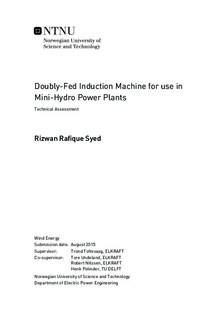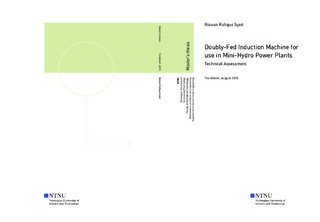| dc.description.abstract | Hydropower is the most popular and fastest growing renewable energy technology among all. Environmental and ecological concerns involved with large water reservoirs limited the usage of potentially available sites. Thus, the present trend is growing towards building small hydro power plants as the hydro power is clean and economical source for power generation.
Different site parameters (head, flow) varies throughout the year which affects the power production capability of hydropower system and makes the production inefficient, in addition, some of the sites cannot be exploited fully just because of being less economical due to these parameter variations. Variable speed operation improves the efficiency of hydro power generation system by running the system at a speed so that the optimum efficiency can be achieved at different operating points. Various configurations are available for variable speed operation and Doubly Fed Induction Generator (DFIG) is also a popular configuration in wind energy systems.
This work is a study to check the performance of DFIG in mini-hydropower system. Firstly, a brief look is taken on steady state model of DFIG which is required to understand the machine characteristics then dynamic model equations for DFIG, grid circuit and DC link are derived which is required for simulation of the system then DFIG model is validated. Optimum efficiency speed module is developed to obtain the speed reference for control system based on power demand for optimum efficiency operation. Finally, control system for DFIG is developed based on vector control.
Performance of the developed model is checked by carrying out simulation at different operating conditions. The power generation capacity is affected by variation in site conditions such as water head. Therefore, the model is simulated at different water heads with different power demands. Further the super-synchronous and sub-synchronous operation of DFIG is checked based on speed reference generated by optimum efficiency speed module. Also efficiency for both variable and fixed speed operation is plotted and it is observed that the efficiency is higher at variable speed operation compared to fixed speed operation for same power demand. | |

